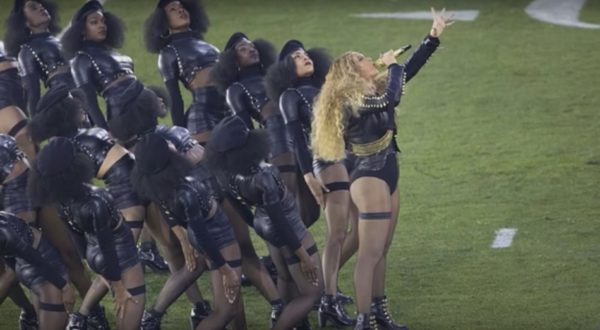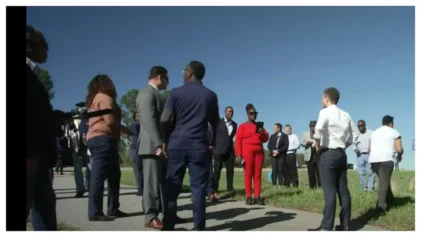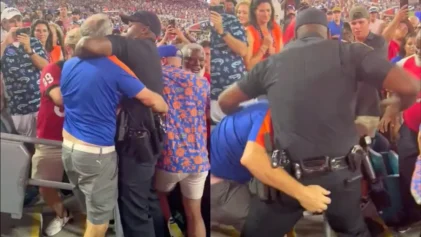The video for “Formation” gives birth to a venerable and radical Beyoncé; it captures the mighty city of New Orleans as a symbol of beauty, resistance and spirituality while condemning police brutality and the government’s failure to prevent Black death and trauma following Hurricane Katrina.
Here, the beauty of Black sexuality is uncensored, seductive, intentional and perfectly controlled. It’s the kind of sexuality that refuses to be romanticized, exploited or ‘fetish-ized.’ Like the Black Panthers who weaved an intricate tapestry of intelligence, class and sexuality, it is raw and systematically applied.
In “Formation,” regaining ownership of one’s sexuality and spiritual and material wealth is required. The labeling of what is mine is in alignment with the case for reparations, the acquisition of lost territory, and the shaming of banks who distribute high-interest loans along racist lines.
Indeed, Black power is not just about embracing Blackness and nurturing physical identity — yes I loved it when Beyoncé sang about loving her man’s “negro nose with Jackson 5 nostrils.” Black power is shaped by a thoughtful decision-making process, which aims to promulgate economic justice (“the best revenge is your paper”) and build wealth for generations to come. And we see Beyoncé’s wealth passed on to Blue Ivy, who makes a welcomed appearance in her mother’s music video.
“Formation” pays homage to the Black Lives Matter Movement, a movement created by women determined to change their community. In recognition of Black feminism, women are the masterful creators behind the scenes, they are deliberate in their perfectly synchronized movements, and every aspect of their organizing — a nod in recognition of these skills is evident by centering them on our screens.
A Black boy in a hoodie — possibly the spirit of 17-year-old Trayvon Martin who was killed by a neighborhood watch volunteer — dances in the presence of police who stand with their hands up (this beautiful role-reversal sees police placed in a position of vulnerability, like so many Black men who are emasculated by state-sanctioned violence).
The spirit of the dancing child is deliberately small in stature, which reminds us that police kill children. His dance functions simultaneously as a tribute to the dead, an expression of the physical and mental creativity needed to express resistance, and a freedom to move across boundaries of the living and the dead. The freedom to transcend the confines of mortality is for some mysterious and threatening, but for many, including myself, an ongoing connection to the dead paves the way for enlightenment, and also Black power.
When I visited New Orleans in January, I watched Black musicians deliver the best live music I’d ever heard, from rock to jazz to blues to folk, their magical talents stretched across every genre. I was also in awe of the Black children dancing or playing instruments as part of a Martin Luther King Day parade. Interestingly, King’s image appears on a newspaper in “Formation” and the ‘X’ of Malcolm X was formed at the Super Bowl. Both images remind us of the continued influence of these great Civil Rights icons.
I am proud to be Ghanaian, and after visiting New Orleans, I immediately felt connected to the Black people there — they reminded me that Blackness is everything: powerful, beautiful and omnipotent.
We saw the woman in “Formation” returning from the dead to challenge a system that allowed her to die in New Orleans. This woman sat on top of a sinking police car — yet another rejection of police brutality.
Indeed, the woman on the car is resilient like the Black women who testified against serial rapist Daniel Holtzclaw; she may have drowned or been overpowered by the horror of sexual oppression, but her spiritual substance means that she will be resurrected, or remain in spirit form until justice prevails.
Beyoncé shows us the power of the musician to use art for Black liberation. Indeed, the Super Bowl performance was similar to the actions of John Carlos and Tommie Smith, who raised their fists in a Black power salute at the 1968 Olympics.
I rolled around in fluffy delight after seeing Beyoncé’s backing dancers adorned in leather clothing and Black Panther-style berets, during a show that rightly embraced sexuality.
Of course, I still question Beyoncé’s entanglement with corporations like Pepsi, but I commend her for her overt declaration of self-love and therefore, Black power.
I’m a Black woman and an activist before I’m a teacher or a writer, which means I’m deeply committed to the Black Lives Matter Movement and connected movements for undocumented immigrants.
Thank you to Beyoncé and her creative team for the centering of Black powerful women, and for remembering the lives lost, like the life of 26-year-old Mario Woods.
I raise my fist in solidarity at this crucial time.





